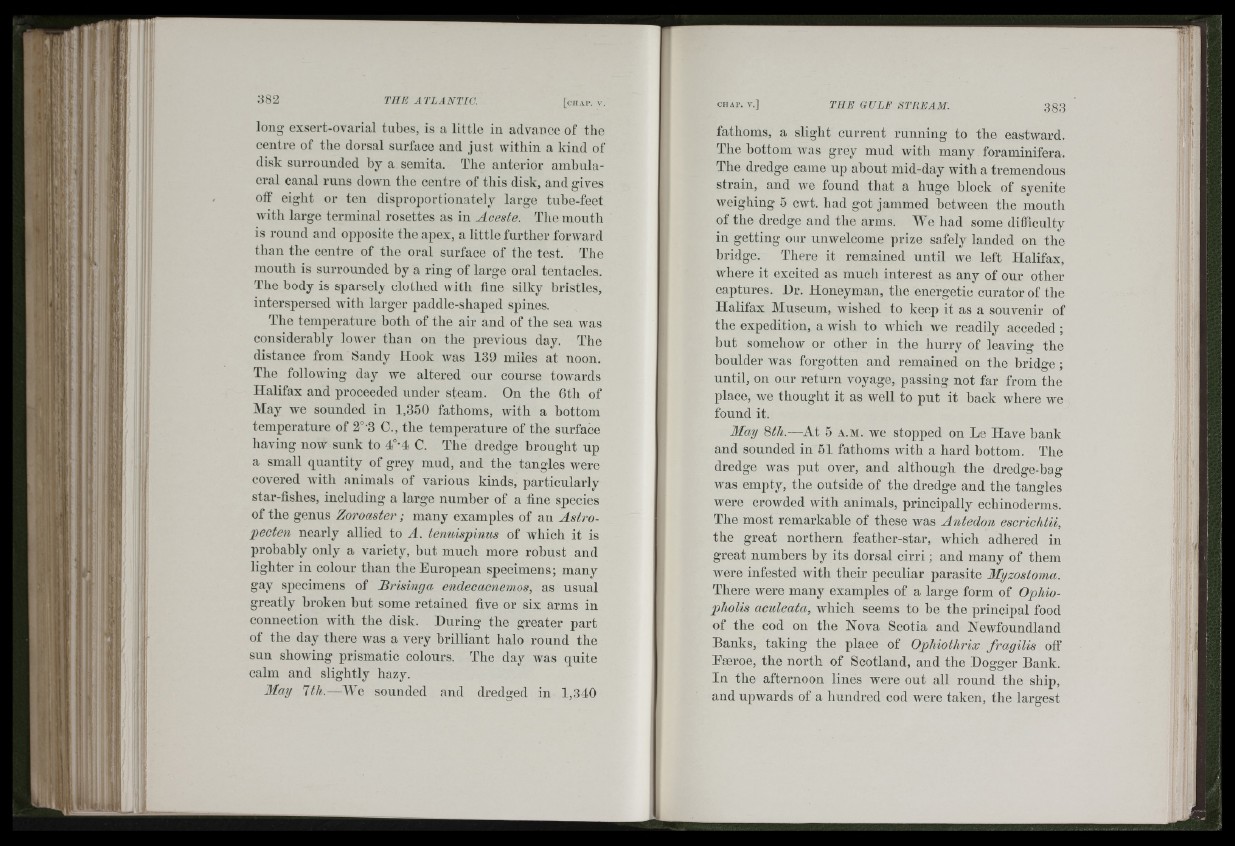
rtii'
iBi
I :
I
long exsert-ovarial tubes, is a little in advance of the
centre of the dorsal surface and ju s t within a kind of
disk surrounded hy a semita. The anterior ambulacral
canal runs down the centre of this disk, and gives
off eight or ten disproportionately large tube-feet
with large terminal rosettes as in Aceste. The mouth
is round and opposite the apex, a little farther foiuvard
than the centre of the oral surface of the test. The
mouth is surrounded by a ring of large oral tentacles.
The body is sparsely clothed with fine silky bristles,
interspersed with larger paddle-shaped spines.
The temperature both of the air and of the sea was
considerably lower than on the previous day. The
distance from Sandy Hook was 139 miles at noon.
The following day we altered our course towards
Halifax and proceeded under steam. On the 6th of
May we sounded in 1,350 fathoms, with a bottom
temperature of 2°-3 C., the temperature of the surface
having now sunk to 4°-4 C. The dredge brought up
a small quantity of grey mud, and the tangles were
covered with animals of various kinds, particularly
star-fishes, including a large numher of a fine species
of the genus Zoroaster; many examples of an Astro-
pecten nearly allied to A. tenuispinus of which it is
probably only a variety, but much more robust and
lighter in colour than the European specimens; many
gay specimens of Brisinga endecacnemos, as usual
greatly broken but some retained five or six arms in
connection Avith the disk. During the greater part
of the day tliere Avas a very brilliant halo round the
sun shoAving prismatic colours. The day Avas quite
calm and slightly hazy.
May 7th.—AA e sounded and dredged in 1,340
fathoms, a slight current running to the eastward.
The bottom Avas grey mud Avith many foraminifera.
The dredge came up about mid-day Avith a tremendous
strain, and Ave found that a huge block of syenite
weighing 5 cwt. had got jammed between the mouth
of the dredge and the arms. AVe had some difficulty
in getting our unwelcome prize safely landed on the
bridge. There it remained until Ave left Halifax,
AA'here it excited as much interest as any of our other
captures. Dr. Honeyman, the energetic curator of the
Halifax Museum, Avished to keep it as a souvenir of
the expedition, a wish to AA'hich we readily acceded;
but somehow or other in the hurry of leaving the
boulder Avas forgotten and remained on the bridge;
until, on our return voyage, passing not far from the
place, we thought it as well to put it back where we
found it.
May Wi.—At 5 a .m . we stopped on Le Have bank
and sounded iu 51 fathoms with a hard bottom. The
dredge Avas p u t over, and although the dredge-bag
Avas empty, the outside of the dredge and the tangles
were crowded with animals, principally echinoderms.
The most remarkable of these was Antedon escrichtii,
the great northern feather-star, which adhered in
great numbers by its dorsal c ir r i; and many of them
Avere infested with their peculiar parasite Myzostoma.
There were many examples of a large form of Ophio-
pholis aculeata, which seems to be the principal food
of the cod on the Nova Scotia and Newfoundland
Banks, taking the place of Ophiothrix fragilis off
Lseroe, the north of Scotland, and the Dogger Bank.
Ill the afternoon lines were out all round the ship,
and upwards of a hundred cod Avere taken, the largest
I
lii I
Is
-iJ I'
(ifti I '
m